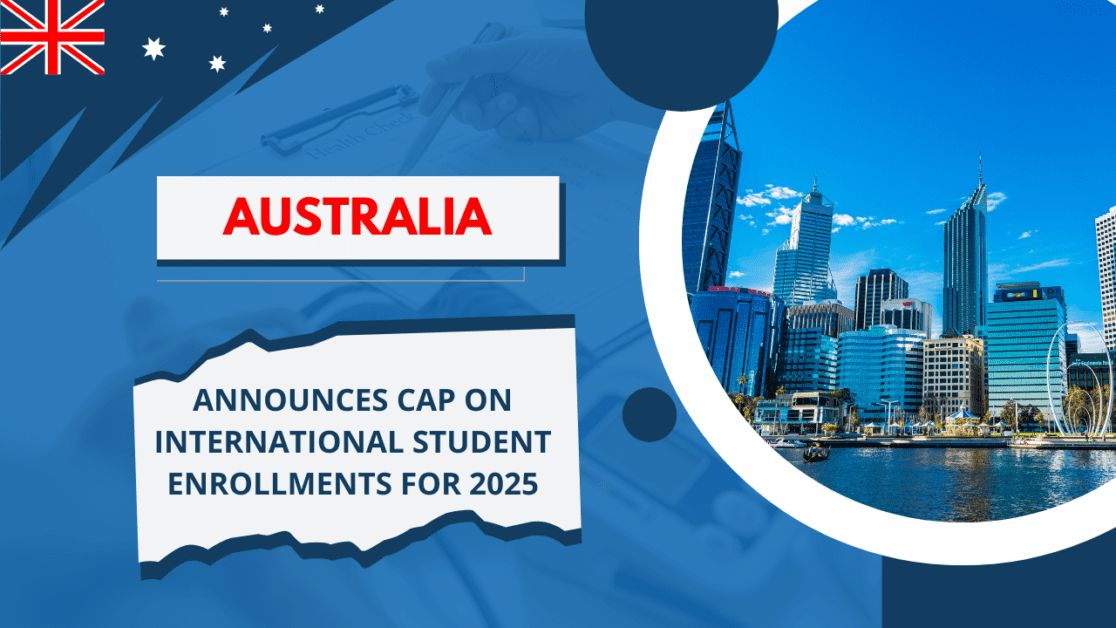
In a significant shift in policy, Australia has announced a cap on international student enrollments, limiting the intake to 270,000 students in 2025. The decision reflects broader concerns around migration, pressure on housing markets, and the quality of education. With Australia being a top destination for international students, particularly those from India, China, and Southeast Asia, this policy change is likely to have a ripple effect on both students and educational institutions.
For aspiring students looking to study in Australia, this move could represent both a challenge and an opportunity. While the competition may intensify, there is still ample time to secure a spot before the changes take full effect. In this blog, we explore the implications of this policy, how it might affect students, and what steps can be taken to stay ahead of the curve.
Understanding Australia’s Motivation Behind the Cap
The Australian government’s decision to cap international student numbers stems from a combination of factors:
Migration Concerns: Australia has long been a desirable destination for migrants, with international students being a significant portion of the migration pipeline. By capping enrollments, the government aims to control migration numbers and manage long-term population growth.
Housing Market Pressures: In recent years, Australia’s major cities, particularly Sydney and Melbourne, have experienced a surge in housing prices and rental costs. International students often contribute to this demand, especially in university-adjacent areas, adding strain to an already tight housing market.
Quality of Education: With international students forming a considerable portion of Australia’s higher education sector, there are concerns that a large influx could compromise the quality of education and resources available to all students. By managing the numbers, the government hopes to maintain a balanced educational ecosystem, ensuring that resources and faculty attention remain evenly distributed.
Who Will Be Affected?
The cap will predominantly affect public universities, vocational training institutes, and other educational providers that rely heavily on international tuition fees. However, there are some exceptions, including:
Research Programs: International students enrolled in research-based programs, particularly PhD candidates, are expected to be largely unaffected by the cap. This exemption underscores Australia’s commitment to maintaining its position as a global leader in research and innovation.
Government-Sponsored Students: Students who are on scholarships or sponsored by their home governments are also likely to be exempt from the cap, as these students contribute significantly to Australia’s diplomatic and economic ties.
Implications for Aspiring Students
For international students planning to study in Australia, this policy change may seem daunting. However, it also presents an opportunity for those who are well-prepared and proactive. Here’s what students can expect:
Increased Competition: With a cap in place, securing a place in Australian institutions will become more competitive. Students will need to ensure their applications stand out, not just in terms of academic performance but also in showcasing their extracurricular achievements, leadership qualities, and unique perspectives.
Higher Admission Standards: As competition increases, universities may raise their admission criteria to ensure they are accepting the best candidates. Students may need to demonstrate higher levels of English proficiency, stronger academic records, and a clear understanding of how their chosen program aligns with their career goals.
Impact on Vocational Education: Vocational education has been a popular option for many international students, particularly those from South Asia. With the cap in place, there may be fewer spots available in these programs, making it crucial for students to explore alternative pathways or higher education programs.
Increased Focus on Postgraduate Studies: While undergraduate programs may see a significant impact, postgraduate studies, especially research-based ones, will likely remain more accessible. Students considering Australia for postgraduate education should focus on aligning their research interests with the strengths of Australian universities, thereby enhancing their chances of acceptance.
Changing Landscape of Scholarships: With the new cap, scholarship opportunities may become more competitive. However, students with exceptional academic records or those from countries with strong diplomatic ties to Australia may still find generous funding options available. It’s important to explore all avenues of financial aid, including government-sponsored scholarships, university-specific awards, and private grants.
Steps to Take for Future Applicants
If you’re planning to apply to Australian universities in the coming years, it’s essential to adapt to this changing landscape. Here are some proactive steps to ensure your success:
Early Application is Key: With limited spots available, students should aim to apply as early as possible to increase their chances of securing a place. Many Australian universities have rolling admissions, meaning that spots are filled as applications are reviewed. Be sure to check the application deadlines and plan accordingly.
Tailor Your Application: As competition intensifies, generic applications will no longer suffice. Ensure that your Statement of Purpose (SOP) highlights why you are uniquely suited for the program, how it aligns with your career goals, and why Australia is your preferred destination for higher education. This is particularly important for those applying for highly sought-after programs in engineering, IT, business, and healthcare.
Focus on Holistic Development: Academic performance is just one part of the equation. Australian universities value well-rounded individuals who demonstrate leadership, community involvement, and a global perspective. Be sure to highlight your extracurricular achievements, volunteer work, and any international experiences that showcase your ability to thrive in a multicultural environment.
Explore Regional Universities: While Sydney and Melbourne are popular destinations, students should also consider universities in regional areas. These institutions often offer excellent programs, smaller class sizes, and a more personalized educational experience. Additionally, the Australian government encourages students to study in regional areas by offering additional post-study work rights.
Leverage Study Abroad Consultancy Services: Navigating the complexities of international applications can be overwhelming. Consulting with study abroad experts, like those at Vrinda International, can provide valuable insights, streamline the application process, and help you identify the best programs and universities suited to your goals. Our team of experienced consultants can guide you through every step, from visa applications to securing scholarships.
The Future of International Education in Australia
While the cap on international student enrollments may initially seem restrictive, it represents a broader shift in how Australia manages its higher education sector. The focus is now on ensuring that international students receive a high-quality education in an environment that supports their academic and personal growth.
For students, this means that while the pathway to studying in Australia may become more competitive, it will also become more rewarding. The new cap will encourage students to bring their best efforts to the application process, resulting in a more vibrant, engaged, and academically driven student community.
At Vrinda International, we remain committed to helping students navigate this evolving landscape. Our expertise in overseas education consultancy, combined with our deep understanding of Australia’s higher education system, ensures that you’ll be well-prepared to achieve your academic and career goals in Australia.
Conclusion
The cap on international student enrollments in Australia is a policy change that reflects the country’s broader economic and social goals. While the cap may pose challenges for some, it also represents an opportunity for dedicated and well-prepared students to secure a place in one of the world’s leading educational destinations. By taking proactive steps, leveraging available resources, and seeking expert guidance, students can ensure they are in the best position to succeed.
For more personalized assistance and up-to-date information on how this policy might affect your application, reach out to Vrinda International today at: +919041818122. Let us help you take the first step toward your Australian education journey!

